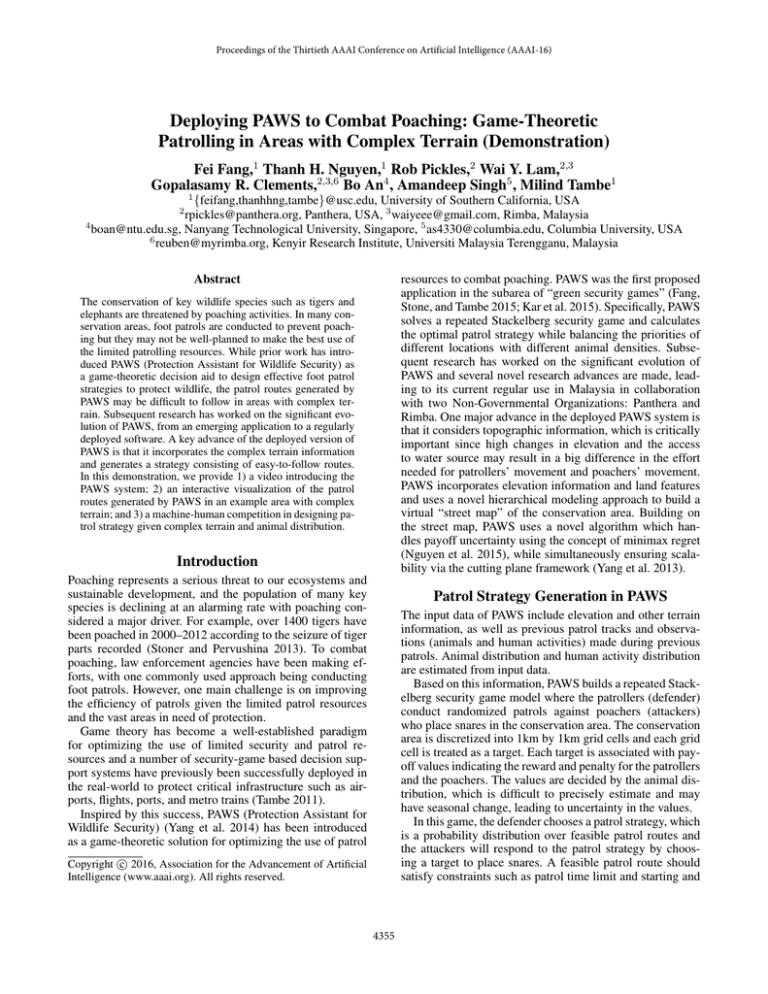
Proceedings of the Thirtieth AAAI Conference on Artificial Intelligence (AAAI-16)
Deploying PAWS to Combat Poaching: Game-Theoretic
Patrolling in Areas with Complex Terrain (Demonstration)
Fei Fang,1 Thanh H. Nguyen,1 Rob Pickles,2 Wai Y. Lam,2,3
Gopalasamy R. Clements,2,3,6 Bo An4 , Amandeep Singh5 , Milind Tambe1
1
{feifang,thanhhng,tambe}@usc.edu, University of Southern California, USA
rpickles@panthera.org, Panthera, USA, 3 waiyeee@gmail.com, Rimba, Malaysia
4
boan@ntu.edu.sg, Nanyang Technological University, Singapore, 5 as4330@columbia.edu, Columbia University, USA
6
reuben@myrimba.org, Kenyir Research Institute, Universiti Malaysia Terengganu, Malaysia
2
resources to combat poaching. PAWS was the first proposed
application in the subarea of “green security games” (Fang,
Stone, and Tambe 2015; Kar et al. 2015). Specifically, PAWS
solves a repeated Stackelberg security game and calculates
the optimal patrol strategy while balancing the priorities of
different locations with different animal densities. Subsequent research has worked on the significant evolution of
PAWS and several novel research advances are made, leading to its current regular use in Malaysia in collaboration
with two Non-Governmental Organizations: Panthera and
Rimba. One major advance in the deployed PAWS system is
that it considers topographic information, which is critically
important since high changes in elevation and the access
to water source may result in a big difference in the effort
needed for patrollers’ movement and poachers’ movement.
PAWS incorporates elevation information and land features
and uses a novel hierarchical modeling approach to build a
virtual “street map” of the conservation area. Building on
the street map, PAWS uses a novel algorithm which handles payoff uncertainty using the concept of minimax regret
(Nguyen et al. 2015), while simultaneously ensuring scalability via the cutting plane framework (Yang et al. 2013).
Abstract
The conservation of key wildlife species such as tigers and
elephants are threatened by poaching activities. In many conservation areas, foot patrols are conducted to prevent poaching but they may not be well-planned to make the best use of
the limited patrolling resources. While prior work has introduced PAWS (Protection Assistant for Wildlife Security) as
a game-theoretic decision aid to design effective foot patrol
strategies to protect wildlife, the patrol routes generated by
PAWS may be difficult to follow in areas with complex terrain. Subsequent research has worked on the significant evolution of PAWS, from an emerging application to a regularly
deployed software. A key advance of the deployed version of
PAWS is that it incorporates the complex terrain information
and generates a strategy consisting of easy-to-follow routes.
In this demonstration, we provide 1) a video introducing the
PAWS system; 2) an interactive visualization of the patrol
routes generated by PAWS in an example area with complex
terrain; and 3) a machine-human competition in designing patrol strategy given complex terrain and animal distribution.
Introduction
Poaching represents a serious threat to our ecosystems and
sustainable development, and the population of many key
species is declining at an alarming rate with poaching considered a major driver. For example, over 1400 tigers have
been poached in 2000–2012 according to the seizure of tiger
parts recorded (Stoner and Pervushina 2013). To combat
poaching, law enforcement agencies have been making efforts, with one commonly used approach being conducting
foot patrols. However, one main challenge is on improving
the efficiency of patrols given the limited patrol resources
and the vast areas in need of protection.
Game theory has become a well-established paradigm
for optimizing the use of limited security and patrol resources and a number of security-game based decision support systems have previously been successfully deployed in
the real-world to protect critical infrastructure such as airports, flights, ports, and metro trains (Tambe 2011).
Inspired by this success, PAWS (Protection Assistant for
Wildlife Security) (Yang et al. 2014) has been introduced
as a game-theoretic solution for optimizing the use of patrol
Patrol Strategy Generation in PAWS
The input data of PAWS include elevation and other terrain
information, as well as previous patrol tracks and observations (animals and human activities) made during previous
patrols. Animal distribution and human activity distribution
are estimated from input data.
Based on this information, PAWS builds a repeated Stackelberg security game model where the patrollers (defender)
conduct randomized patrols against poachers (attackers)
who place snares in the conservation area. The conservation
area is discretized into 1km by 1km grid cells and each grid
cell is treated as a target. Each target is associated with payoff values indicating the reward and penalty for the patrollers
and the poachers. The values are decided by the animal distribution, which is difficult to precisely estimate and may
have seasonal change, leading to uncertainty in the values.
In this game, the defender chooses a patrol strategy, which
is a probability distribution over feasible patrol routes and
the attackers will respond to the patrol strategy by choosing a target to place snares. A feasible patrol route should
satisfy constraints such as patrol time limit and starting and
c 2016, Association for the Advancement of Artificial
Copyright Intelligence (www.aaai.org). All rights reserved.
4355
ending at the base camp and should be easy to follow by
the patrollers. To find such routes, PAWS incorporates topographical information and builds a virtual “street map” of
the conservation area. Essentially, the street map connects
the whole conservation area through easy-to-follow route
segments such as ridgeline, streams and river banks – terrain features which patrollers find easier to move around
than on slopes. In addition, focusing on these terrain features also ensures the patrol routes are effective. The reason
is two-fold: (i) they are important conduits for certain mammal species such as tigers; (ii) hence, poachers use these features for trapping and moving about in general. PAWS also
uses the SUQR model (Nguyen et al. 2013) to model the
bounded rationality of attackers.
Given the game model, PAWS calculates the optimal patrol strategy for the defender, which consists of a set of
patrol routes and the probabilities with which each route
should be taken. PAWS uses a novel algorithm which integrates two threads of prior work in the security games literature, ARROW (Nguyen et al. 2015) and BLADE (Yang
et al. 2013). This algorithm generates patrol routes over the
street map, while simultaneously addressing payoff uncertainty and bounded rationality of the adversary.
In wildlife protection, there are repeated interaction between patrollers and poachers. When patrollers execute the
PAWS strategy over a period (e.g., three months), more information is collected and can become part of the input in
the next round.
Figure 1: Example patrol routes generated by PAWS.
a poacher, the total distance and total elevation change of the
patrol routes, the number of climbing ups and downs if the
patrollers follow the patrol routes.
Acknowledgement
This research was supported by MURI Grant W911NF-111-0332.
References
Fang, F.; Stone, P.; and Tambe, M. 2015. When security
games go green: Designing defender strategies to prevent
poaching and illegal fishing. In International Joint Conference on Artificial Intelligence (IJCAI).
Kar, D.; Fang, F.; Fave, F. D.; Sintov, N.; and Tambe, M.
2015. A Game of Thrones: When human behavior models
compete in repeated Stackelberg security games. In AAMAS
2015.
Nguyen, T. H.; Yang, R.; Azaria, A.; Kraus, S.; and Tambe,
M. 2013. Analyzing the effectiveness of adversary modeling
in security games. In AAAI.
Nguyen, T. H.; Fave, F. M. D.; Kar, D.; Lakshminarayanan,
A. S.; Yadav, A.; Tambe, M.; Agmon, N.; Plumptre, A. J.;
Driciru, M.; Wanyama, F.; and Rwetsiba, A. 2015. Making the most of our regrets: Regret-based solutions to handle
payoff uncertainty and elicitation in green security games.
In Conference on Decision and Game Theory for Security.
Stoner, S., and Pervushina, N. 2013. Reduced to skin and
bones revisited: An updated analysis of tiger seizures from
12 tiger range countries (2000-2012). Report, TRAFFIC:
The Wildlife Trade Monitoring Network.
Tambe, M. 2011. Security and Game Theory: Algorithms,
Deployed Systems, Lessons Learned. Cambridge University
Press.
Yang, R.; Jiang, A. X.; Tambe, M.; and Ordonez, F. 2013.
Scaling-up security games with boundedly rational adversaries: A cutting-plane approach. In IJCAI.
Yang, R.; Ford, B.; Tambe, M.; and Lemieux, A. 2014.
Adaptive resource allocation for wildlife protection against
illegal poachers. In AAMAS.
Demonstration
Our demonstration consists of three parts. The first part is a
video introducing the PAWS system. This video presents an
urgent need to combat poaching, the problem scenario, the
challenges of solving the problem, the PAWS framework, as
well as the real-world deployment of PAWS patrols.
The second part is an interactive visualization of the patrol
routes generated by PAWS in an example area with complex
terrain. We will show the patrol routes on Google Earth (see
Figure 1). Thus participants can get a 3-D view of the routes
and rotate to check whether the patrol routes are compatible
with the terrain and are feasible.
The third part is a machine-human competition in designing patrol strategy given terrain information and animal distribution. The participants will be asked to design their own
patrol strategy and compare it to the strategy generated by
PAWS. As the first task of the competition, the participants
can assign probabilities to a given set of patrol routes. We
will compare the results with the optimal probabilities generated by PAWS, the patroller’s expected utility against a
poacher. As the second task of the competition, the participants will be asked to design a patrol strategy, including a
set of patrol routes and probabilities of taking each route,
given animal density distribution map overlaid on a topographic map. The patrol routes should start from and end
with a given base camp location, and satisfy the total patrol
time limit. We will make a descriptive comparison between
the strategy generated by participants and the strategy generated by PAWS. Multiple criteria will be included in the
comparison, including the patroller’s expected utility against
4356



